“Transmodern Cyberpunk Literature: Joanna Kavenna’s Zed (2019)”
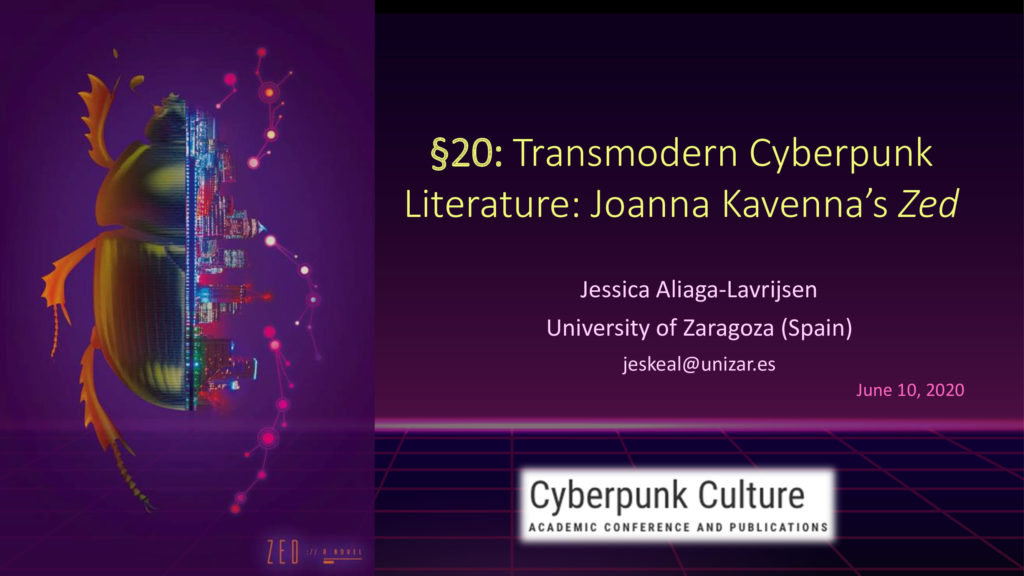
Introduction: Transmodernity
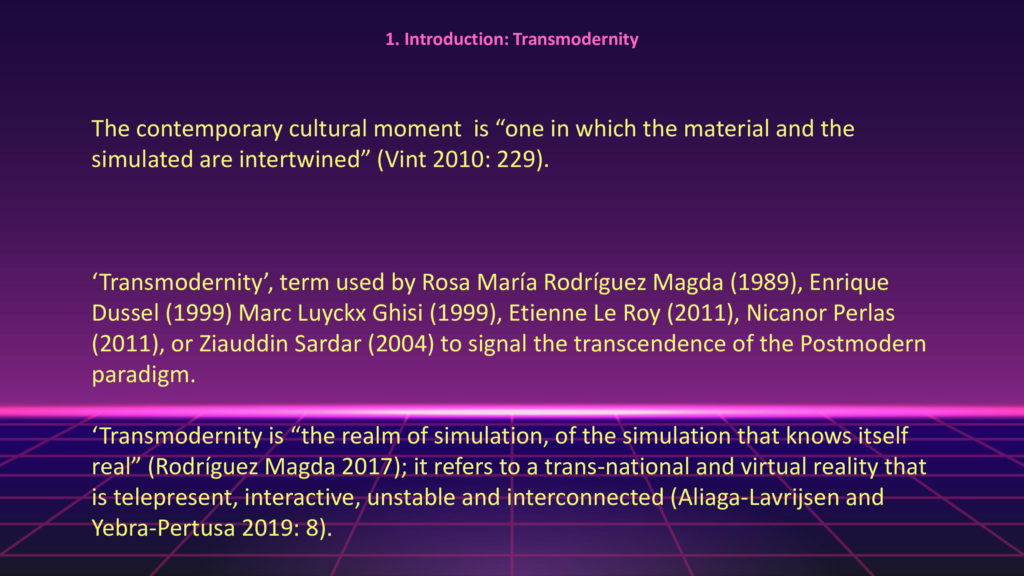
As this CyberPunk Culture Cyberconference is making evident, the literary subgenre of cyberpunk has successfully reinvented itself into the twenty-first century. Sherryl Vint defines the contemporary cultural moment as “one in which the material and the simulated are intertwined” (2010: 229). Along the same lines, what some authors such as Rosa María Rodríguez Magda (1989), Enrique Dussel (1999) Marc Luyckx Ghisi (1999), Etienne Le Roy (2011), Nicanor Perlas (2011), or Ziauddin Sardar (2004) have termed ‘Transmodernity’ has been said to be “the realm of simulation, of the simulation that knows itself real” (Rodríguez Magda 2017). Transmodernity signals the transcendence of the Postmodern paradigm (Rodríguez Magda 2017) and refers to a trans-national and virtual reality that is telepresent, interactive, unstable and interconnected (Aliaga-Lavrijsen and Yebra-Pertusa 2019: 8). The shift from Postmodernity to Transmodernity, which most authors place at the beginning of the 1980s, suggests that we need a new interpretative grid capable of articulating the new reality (Onega and Ganteau 2020: 7).
For these reasons, it is my hypothesis that a Transmodern approach to a contemporary cyberpunk novel is especially suitable to analyse the representations of a world in which virtual interactions shape reality.
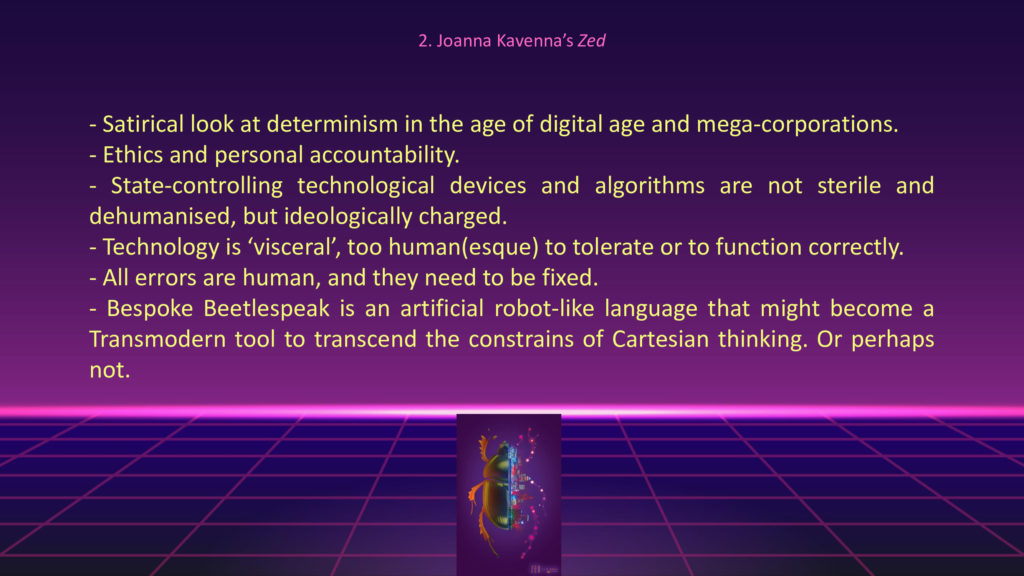
Joanna Kavenna’s Zed
Joanna Kavenna’s latest novel, Zed (2019), offers a satirical and dark-humorous look at the age of digital age and mega-corporations. However, and in tune with the Transmodern literature of the last decades, ethics and personal accountability have special relevance in the text. As the analysis will show, in the dystopic Britain presented in Zed, state-controlling technological devices and AI algorithms are not represented as sterile and dehumanised apparatus, but rather as ideologically charged. Moreover, technology has become ‘visceral’ in the sense that it is sometimes too human(esque) to tolerate or to function correctly. Nevertheless, all possible and existing errors are considered to be exclusively human elements. In this reality of human-technological symbiosis, where fridges, wrist bands and algorithms tell you what to do, new things are emerging, as suggested by perhaps the most innovative element in Kavenna’s narrative: the author manages to convey the content of virtual technology onto the form of her writing, by introducing BeetleSpeak language. This paper intends to explore whether, from a Transmodern perspective, this artificial robot-like and paradoxical language might become a tool to transcend the constrains of Cartesian thinking or not.
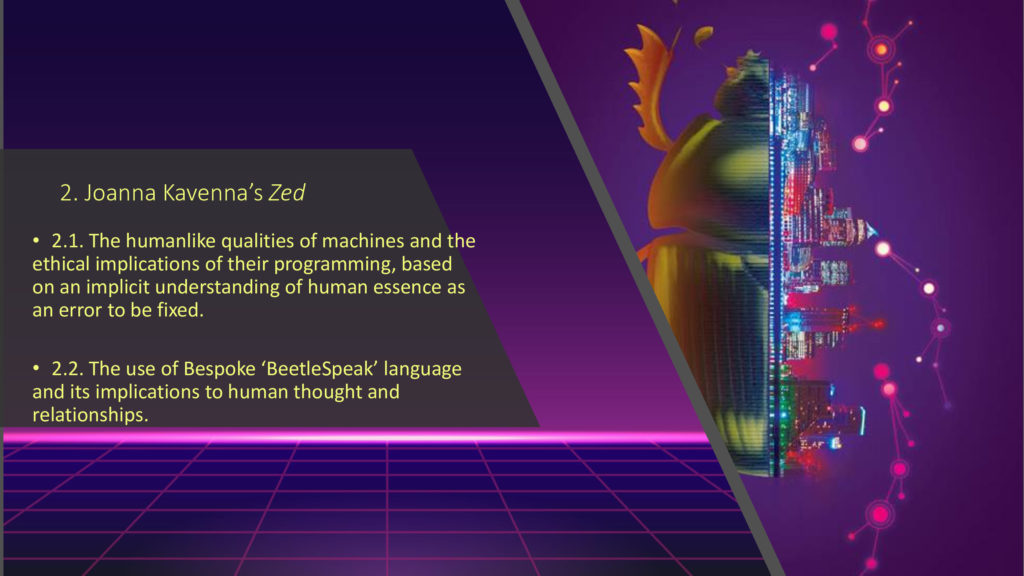
The analysis will be structured thus along two main points of interest. Firstly, it will focus on the humanlike qualities of machines and the ethical implications of their programming, based on an implicit understanding of human essence as an error to be fixed. And secondly, it will examine the use of Bespoke Beetlespeak language and its implications.
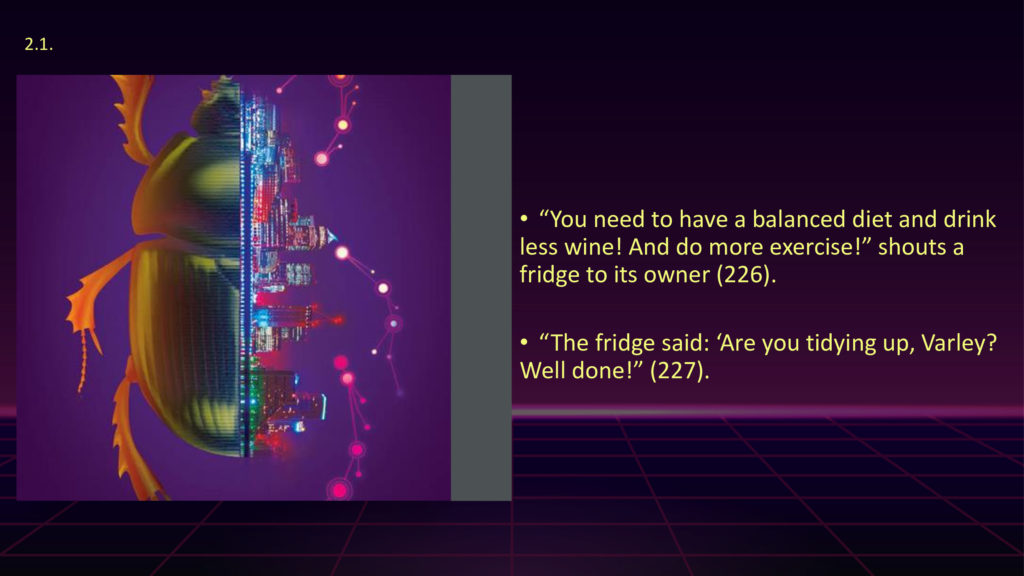
As stated above, in the society portrayed in Kavenna’s novel, in which everything from education, employment, the economy, the media, surveillance or people’s behaviour is controlled by a megacorporation called Beetle, humans have established a symbiotic relationship with AI. Smart wristbands—called Beetlebands—, and fridges tell characters what to do in a patronising and even quite irritating way: “You need to have a balanced diet and drink less wine! And do more exercise!” shouts a fridge to its owner (226). Sometimes they sound more reproachfully and paternalistic, infantilising the owners: “The fridge said, ‘Are you tidying up, Varley? Well done!” (227). The relationship that people establish with their appliances sometimes resembles that of an unwelcome friendship.
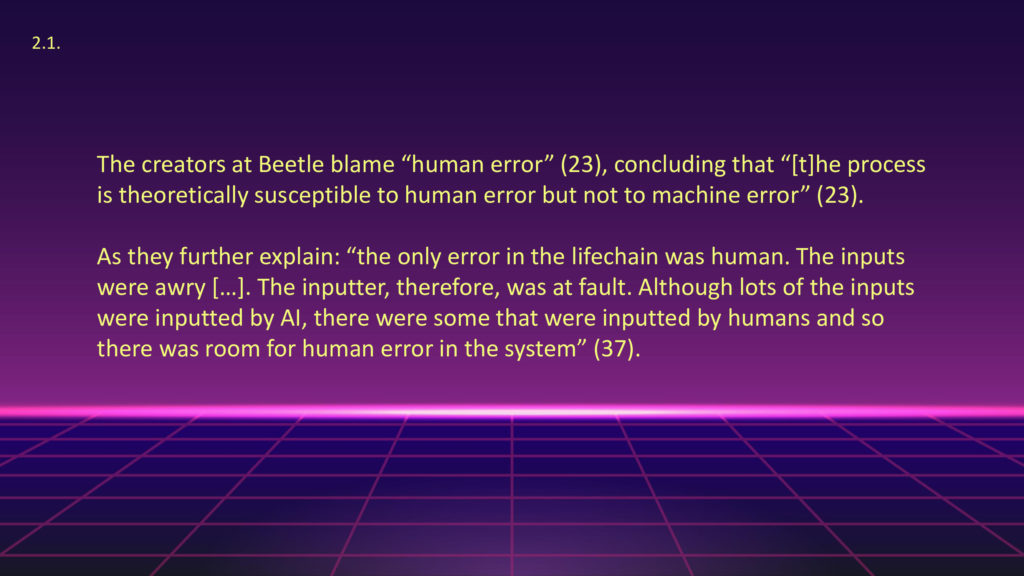
But things can get more serious, as for example when, based on a predictive algorithm—called “predictive lifechain” (2010: 20)—, that will remind many readers of Philip K. Dick’s Minority Report, an Anti-Terror Droid (ANT) shoots a man in a café, having mistaken him for another man who was supposedly going to commit a crime in the future. Despite the fact that the ANT “was programmed to perform complex negotiations with terrorists” (16), it kills Lionel Bigman for no reason at all, except for a possible glitch (20). However, when his wife demands personal accountability for the killing, which is defined on the news as “suicide by droid” (25 and 28), the creators at Beetle blame “human error” (23), concluding that “[t]he process is theoretically susceptible to human error but not to machine error” (23). As they further explain: “the only error in the lifechain was human. The inputs were awry […]. The inputter, therefore, was at fault. Although lots of the inputs were inputted by AI, there were some that were inputted by humans and so there was room for human error in the system” (37).
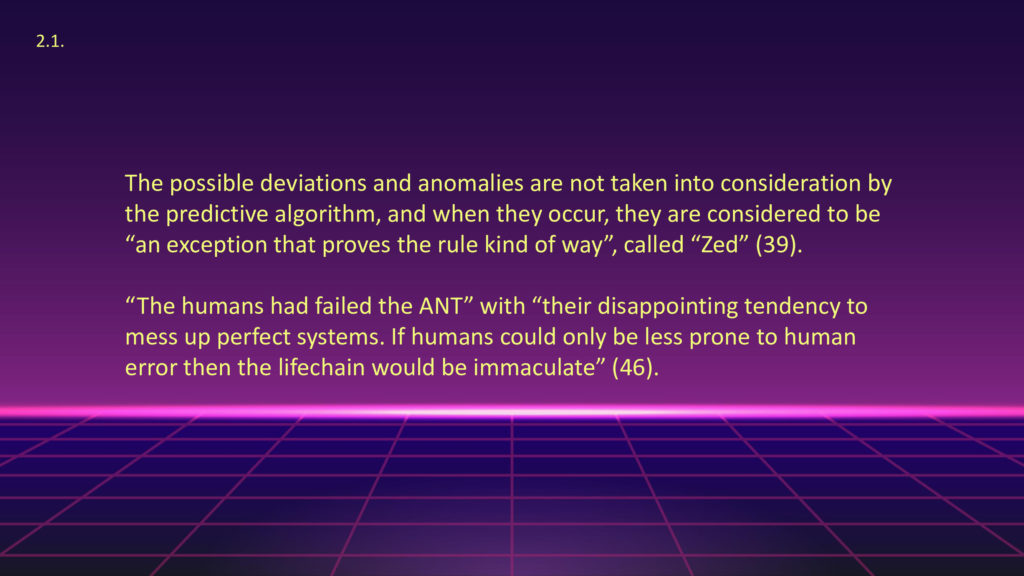
The possible deviations and anomalies are not taken into consideration by the predictive algorithm, and when they occur, they are considered to be “an exception that proves the rule kind of way”, called “Zed” (39). No responsibility is taken by Beetle, as they believe that the ANT’s system is perfect. As they further state: “The humans had failed the ANT” with “their disappointing tendency to mess up perfect systems. If humans could only be less prone to human error then the lifechain would be immaculate” (46). In conclusion, “humans should be more clearly educated in Beetle protocols” (47), that is, they should adapt to the narrow and lineal thinking of the machines created by Beetle, represented in “very simple and beautiful diagram(s)” (21) that seem quite inaccurate, to say the least, from a human perspective.
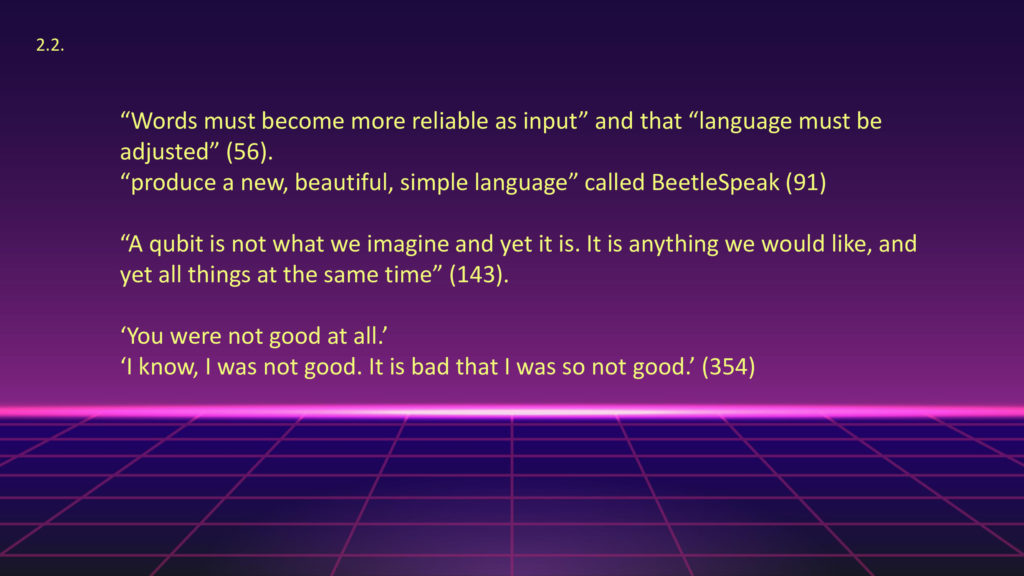
Along these lines, and believing that some of these errors where language errors and not machine errors, employees of Beetle conclude that “[w]ords must become more reliable as input” and that “language must be adjusted” (56). Then, some linguists at Beetle “produce a new, beautiful, simple language” called BeetleSpeak (91)—which many readers will interpret as a reference to George Orwell’s Newspeak (1949)—. In a sense, the language at first results to be good at representing paradoxical realities, and a certain transcendence of Cartesian thinking might be achieved, in the human tendency to resolve paradoxes: “A qubit is not what we imagine and yet it is. It is anything we would like, and yet all things at the same time” (143). Qubits and BeetleSpeak transcend binaries, however, most characters “liked the old world. One or zero. One or the other. Not both” (145). It gives them a certain stability. However, as the language is further simplified by Beetle, and becomes “even more neutral” (354) communication, and thus thinking become quite silly:
‘You were not good at all.’
‘I know, I was not good. It is bad that I was so not good.’ (354)
The megacorporation seems to own everything, and real revolution might not be possible after all. Nevertheless, the novel ends up offering some hope, at least on a personal level.
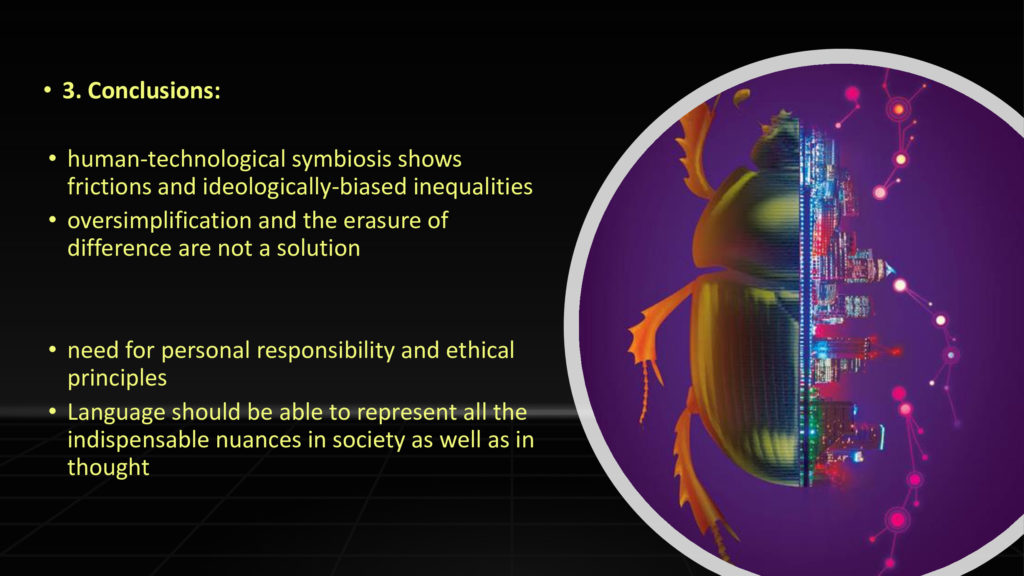
Conclusions
The human-technological symbiosis is thus not as ideal as one would desire, and there are many frictions and ideologically biased inequalities. Despite the difficulties found in this relationship, oversimplification and the erasure of difference are not a solution. In Joanna Kavenna’s dystopia, the need for personal responsibility and ethical principles becomes evident. And finally, if we do not want language to reduce understanding and limit our thoughts (274), it should be able to represent all the indispensable nuances in society as well as in thought.
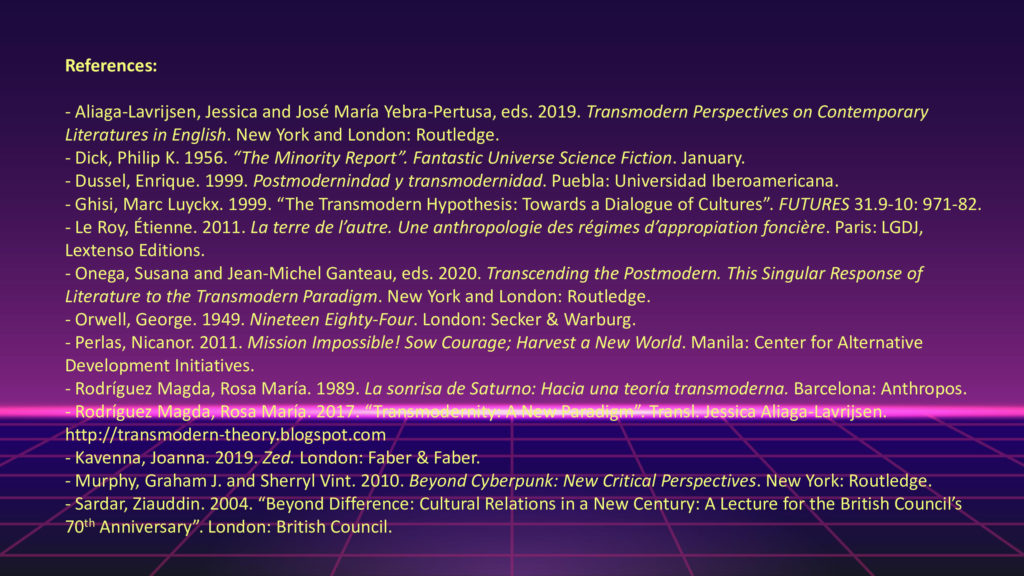
References
- Aliaga-Lavrijsen, Jessica and José María Yebra-Pertusa, eds. 2019. Transmodern Perspectives on Contemporary Literatures in English. New York and London: Routledge.
- Dick, Philip K. 1956. “The Minority Report”. Fantastic Universe Science Fiction. January.
- Dussel, Enrique. 1999. Postmodernindad y transmodernidad. Puebla: Universidad Iberoamericana.
- Ghisi, Marc Luyckx. 1999. “The Transmodern Hypothesis: Towards a Dialogue of Cultures”. FUTURES 31.9-10: 971-82.
- Le Roy, Étienne. 2011. La terre de l’autre. Une anthropologie des régimes d’appropiation foncière. Paris: LGDJ, Lextenso Editions.
- Onega, Susana and Jean-Michel Ganteau, eds. 2020. Transcending the Postmodern. This Singular Response of Literature to the Transmodern Paradigm. New York and London: Routledge.
- Orwell, George. 1949. Nineteen Eighty-Four. London: Secker & Warburg.
- Perlas, Nicanor. 2011. Mission Impossible! Sow Courage; Harvest a New World. Manila: Center for Alternative Development Initiatives.
- Rodríguez Magda, Rosa María. 1989. La sonrisa de Saturno: Hacia una teoría transmoderna. Barcelona: Anthropos.
- Rodríguez Magda, Rosa María. 2017. “Transmodernity: A New Paradigm”. Transl. Jessica Aliaga-Lavrijsen. http://transmodern-theory.blogspot.com
- Kavenna, Joanna. 2019. Zed. London: Faber & Faber.
- Murphy, Graham J. and Sherryl Vint. 2010. Beyond Cyberpunk: New Critical Perspectives. New York: Routledge.
- Sardar, Ziauddin. 2004. “Beyond Difference: Cultural Relations in a New Century: A Lecture for the British Council’s 70th Anniversary”. London: British Council.
Discord Discussion
This discussion has been copied from the Discord server, names have been reduced to first name, discussion threads have been grouped and edited for better readability.